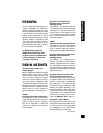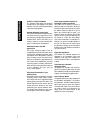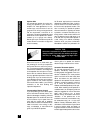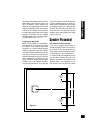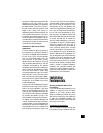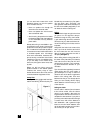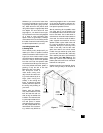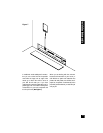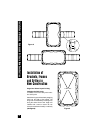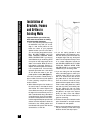
image is created. Here are some guidelines
to make the process of placement quick
and easy.
Make sure the sound will not be blocked or
reflected off of furniture or other objects.
You should have a direct line of sight with
the front of the speaker. To determine the
best position, measure the “listening” dis-
tance between the ideal listening position
(your favorite chair or couch) and the wall
in which you plan to install the speakers.
Try to place the speakers so that they are
equally distant from your listening spot and
at least one half of the listening distance
apart (this maintains a large pleasant stereo
“image”). In home theater applications
where there is a center channel you may
choose to space the left and right main
speakers farther apart for a “bigger than
life” sound with Dolby
®
encoded movies
and TV shows. However, for combined
music and movie usage stay within the
good placement zone for music. For exam-
ple; if you are ten feet back from the wall,
the speakers should be between five and
ten feet apart (See Figure 2).
The Boundary Effect
Corners can affect the bass response of the
speaker powerfully! This is called the
boundary effect. You will emphasize par-
ticular bass frequencies and cancel out
other bass frequencies when you place
speakers close to the wall/ceiling boundary
or a corner wall boundary. This can make
the speaker sound excessively boomy and
inaccurate to some listeners, while to oth-
ers it just seems like more bass sound. A
good rule of thumb is if you always listen
to your current pair of speakers with the
bass turned up, you’ll enjoy corner place-
ment. If you keep your preamp or receiv-
er’s tone controls at neutral, try to keep the
speakers at least one or two feet from the
boundaries of the room. The baffle-mount-
ed Acoustical Configuration Controls may
be used to help reduce the affect of corner
placement (or the room’s own acoustics)
on the speakers performance. (For more
information, see Setting the Tone Controls
on page 15).
Placement for Varying Listening
Positions
If you want the freedom to sit anywhere in
a room facing any direction, and/or find
that you prefer the “all around you” sound
of some car stereos to a conventional
“sound stage” facing you, consider the
speaker placement techniques professional
installers use in restaurants and bars. They
place speakers in an array around the lis-
tening area, so that the music is always sur-
rounding you, regardless of the direction
you face.
The rule of thumb is to add one pair of
speakers for every 100 to 200 square feet
of listening area. Curiously, this is not so
that you can play the music louder, but so
that you can play it softer! When you have
only one pair of speakers in a large room
you will notice that when the sound is per-
fect in one part of the room, it is too loud
near the speakers. By placing more than
one pair in the room you will avoid these
“hot spots” of loud sound and create more
sonic ambiance while maintaining clarity
and rich sound everywhere.
You can make listener position even less
critical by using mono rather than stereo.
This can be difficult to achieve with normal
stereo amplifiers. However, Niles manu-
factures Systems Integration Amplifiers
which enable one room to be wired in
stereo while other rooms are wired in
mono! Consult your local Niles dealer for
more information.
In smaller rooms or rooms that are infre-
quently used, you typically can’t justify the
expense of more than two speakers. Try to
bracket the room with the two speakers.
Diagonal placement is a very effective way
to stretch the coverage pattern of two
speakers. You can also compromise
between direct sound (for detail and clari-
ty) and reflected sound (the ambient or “all
Speaker Placement
6





